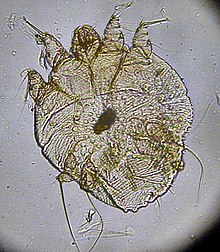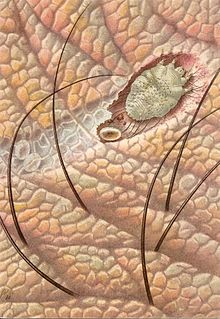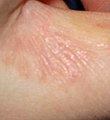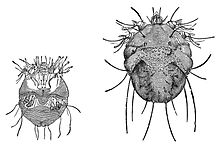Scabies
Scabies or scabies or scabies is a skin disease caused by the parasitic mite Sarcoptes scabiei, commonly called scabies plower. It is a cosmopolitan ectoparasitosis, extremely contagious. It reaches all levels of the population and constitutes a very frequent dermatosis that is relatively easy to treat.
Etiology
The cause of this disease is the "arador de la mange" or Sarcoptes scabiei which is a mite with a non-segmented, ovoid body, with four pairs of legs. The female measures 300-450 microns and the male 150-250 microns.
Main features:
- Guest: the human. This mite lives no more than two to four days in the environment.
- Contagio: the disease is transmitted by direct and prolonged contact with infected skin. Rarely, the transmission can be given by contacting the limits (preads, clothes, sheets, towels, tables, chairs) contaminated at the same time, not once 24-36 hours have passed.
- Incubation:
- Primoinfestation (persons without prior exposure to mite): five to fifteen days
- Reinfestation (persons who have been previously infested): one to four days
Fertilization occurs on the surface of the skin. After copulation the male dies.
The female burrows into the stratum corneum of the skin and develops tunnels. There it lays its eggs and, as it penetrates the skin, it secretes toxins that cause allergic reactions, laying two or three eggs per day for a total of between thirty and fifty eggs and finally dies in the tunnel at four to six. weeks. The eggs hatch and the larvae emerge to the surface of the skin, transform into nymphs in three to eight days, and later into adults in twelve to fifteen days. The contagious forms are the nymph and the adults.
Clinical picture
The main symptom is persistent itching, which intensifies at night and in the heat. The itching is caused by the body's allergic reaction to the parasite, which manifests as small pimples, blisters and small crusty ulcers. It does not cause fever, unless there is an infestation.
The most frequent lesions are erythematous papules and bloody crusts, the latter are products of scratching, however, the most typical lesions that are of great help for diagnosis are furrows, grayish and sinuous lines from 1 to 15 mm long, which are the external reflection of a gallery excavated in the epidermis by the female for the purpose of spawning, and the pearly vesicles, the thickness of a pinhead, produced by the secretion of the parasite. These lesions, which predominate on the wrists, the sides of the fingers and hands, the elbows, and the buttocks, extend to the entire body. Some locations are elective, and not necessarily always present: in the male, the prepuce and glans (scabious chancre); in women, the areola (outside breastfeeding, bilateral lesions on both breasts suggest scabies); in children and infants, the soles of the feet.
Scabies can be accompanied by lesions induced by microbes (pyodermitis, lymphangitis, etc.). For its part, in people without microbial infestations of this type, it does not result in more than a minimum of symptoms and is not itchy. However, it is equally contagious.
Classification
- Sarna mitis
- Nodular sarna
- Norwegian sarna (in immunodepressed): very contagious form, a massive infestation occurs, thousands of females are present being the usual 10 to 20 thousand females.
Treatment
Scabies is treated with scabicides, which must be applied all over the body, not just the parts with evidence of being infested, since the exact location of the parasite is not known, since if they are adults they can spread throughout the body. Among the most widely used scabicides are permethrin, lindane, benzyl benzoate, crotamiton, and salvador balsam (see Myroxylon pereirae). Special care must be taken when applying the treatment, avoiding the mucous membranes and spreading the product through all the folds of the skin, the interdigital spaces and the area between the nails and the skin, since the parasite can use these areas as reservoirs. The treatment lasts from three to five days if it is done properly and it is necessary to repeat the application a week later for another three days. Some serious accidents have occurred when people applied Lindane improperly. This acaricide and pesticide can only be applied in a dilution and dosage controlled by a doctor[citation required]. This disease is very contagious and therefore the treatment must be done by all the people who live in the same house. The mite can live for up to thirty hours on clothing and hair and therefore clothing must be disinfected, either by soaking it in boiling water or by exposing it to the sun for four hours.
Oral treatment is performed with ivermectin in drops or tablets, at a rate of 200 μg/kg of weight, in a single dose. A second dose is repeated two to three weeks later if it persists. It is contraindicated in pregnancy and lactation.
Mange in Animals
Scabies can occur in a considerable number of species of domestic and wild animals. The mites that cause these infestations (acariasis) are of different species and subspecies, depending on the case. These subspecies can infest animals or humans that are not their usual hosts, but these types of infestations do not last long. Animals infected with mange suffer from severe itching and secondary skin infections. They often lose weight and their health becomes fragile.
The most frequently diagnosed form of mange in domestic animals is sarcoptic mange of dogs.
Poultry infested with scab get what is known as "foot scab.
Domestic animals that have become feral and do not receive veterinary care are frequently infested with mange and a host of other diseases. It has been observed that non-domestic animals can also suffer from scabies. Gorillas, for example, are known to be susceptible to infestation through contact with objects used by humans.
Contenido relacionado
Tetraplegia
Hemophilia
Polymastia








